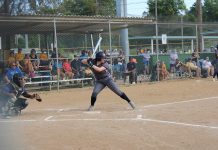Webster University baseball coach Bill Kurich called it the worst string of pitchers’ bad luck he has ever heard of or experienced. In his seven seasons at the helm of the baseball program, the team suffered only one surgery for a player — until 2011.
“At one point it was almost laughable the amount of injuries we continue to incur,” Kurich said. “That’s part of the memory of last year — not just how well we did and how far we got — but what we overcame.”

Four pitchers on the Webster roster — sophomore Jack Bensinger, juniors Jason Gray, Zach Schneider and Dylan Dean Smith — missed all of last season with injuries. Gray, Schneider and Smith are all back on the mound for the Gorloks this season, while Bensinger is still out with a shoulder injury.
In 2011, Gray, the team’s closer this season, was statistically one of the best relievers on the roster. He was 5-0 with a 1.75 ERA. He pitched nearly 26 innings and surrendered only 5 earned runs.
After his freshman season, Gray underwent Tommy John surgery on his right elbow in October 2011 and missed all of 2012. Gray said it takes six months to a year to recover from Tommy John surgery.
“I got the surgery right before the Cardinals’ World Series (October 2011), and I remember sitting on my couch after I had the surgery and was just thinking, ‘I want to do something like that.’ And then our team went to the (College) World Series (May 2012), so it definitely put things in perspective for this year,” Gray said.
Schneider came to Webster and became the No. 2 starter for the Gorloks his freshman year. In 77 1/3 innings, opponents only batted .191 against him and struck out 83 times — which ranked No.1 in both categories for Webster pitchers in 2011. Schneider finished his first year of college ball with a 7-4 record and a 1.86 ERA.
Schneider said halfway through the season he got hurt but not so badly he couldn’t play. Then, he said, he noticed something that was more than his usual soreness the day after pitching. An MRI test showed no damage, but the summer after Schneider’s freshman year, he was shut down to give his arm a rest.
Schneider was shut down all fall. It wasn’t until spring 2012 when he began to pitch that he realized he would be shut down the rest of his sophomore season.
“I started pitching again (in spring 2012), and by the time I threw like 10 pitches it felt like it was 100,” Schneider said. “So I just got really tired really quick, so that’s when we decided I needed surgery.”
The diagnosis was that Schneider tore his labrum — a muscle that goes around your ball socket joint — in his left shoulder. Doctors used one anchor — a knot that is looped around the torn tissue and tied off — to reattach his labrum in its proper position.
Smith underwent the same injury as Schneider, the main difference being Smith had surgery on his right shoulder.
Smith, similarly to his two teammates, had a statistically good first year with the Gorloks. Smith showed off his versatility as he made 6 starts in 11 appearances for Webster with a 4-0 record in 2011. He said his pain started at the end of the season when he had bicep tendinitis, and decided to have surgery in the fall.
Gray and Schneider were both selected to the St. Louis Intercollegiate Athletic Conference All-Conference second team that year.
The recovery process
Smith was the first of the Gorlok pitchers to go down with injury. Smith began rehab two to three weeks after surgery. He said his rehab program lasted two months.
“I think another thing that helps overcome injuries is mine and Zach’s (Schneider) success,” Smith said. “(I had) the same surgery as him, and if you just put some time, you’ll fully recover. So I think it’s all three of us, and the team picking each other up during the injury time definitely helps in the recovery time as well.”
Schneider said the typical surgery for a non-athletic person requires four to six months of recovery, but for a baseball player it’s a nine- to 12-month recovery and within that time is when one can begin to pitch again.
Gray, Schneider and Smith had never had a baseball-related injury in their careers until they were hurt.
Some of the different exercises involved with recovery program for pitchers include:
—Squeezing a Styrofoam ball.
—Physical therapy sessions (for stretches and exercise activities).
—One-pound light weight lifting.
Once the pitchers have gone through that process, they progress toward a throwing program. In that program, Schneider said people typically begin with 40 feet and 10 throws and then move to 60 feet and 20 throws. This process is done twice, with a day’s rest in between.
Schneider said it was a cool journey, but also difficult.
“It’s definitely really tough,” Schneider said. “You really got to keep that in mind or in focus because it’s hard to just not being able to put a backpack on, or you’re so used to throwing a ball. And then having a year off without throwing it, you’re just like, ‘Oh, what’s this again?’ It’s a huge mental process of having your pitching form and your mechanics; having them solid and ingrained where you don’t even think about it — you just get on the mound and throw — but to have to re-learn how to pitch again … it’s harder than I thought.”
Kurich said because Gray and Smith had their surgeries earlier (in October 2011), they were back sooner. He said Schneider is still in a rehab situation because he did not have surgery until April 2012, but he still pitches.
Turning negatives into positives
Despite the loss of three of their pitchers, the Webster baseball team was still able to have its best season in program history — a fifth place finish at the College World Series in Appleton, Wis.
With multiple pitchers out of the staff, Kurich was forced to restructure the way he used his pitchers. Kurich said he had to throw then-senior David Mueller and current senior Steven Dooley on short rest and in relief, which he wouldn’t normally do because of the strain it puts on players’ arms. In spite of all the pitching injury trouble, however, sophomore Isaac Behme emerged. As a freshman, Behme went 6-2 with an ERA of 2.21 in just over 69 innings.

Now that Gray, Schneider and Smith are back, they are picking up where they left off as freshmen. Gray is back as the stopper at the back end of games and has yet to give up an earned run this season. Schneider is 1-0 in 4 appearances with an ERA of 1.38.
But Smith may have accomplished the most of the three. Smith threw the first no-hitter in Webster history — a game where he did not surrender a walk, and struck out 9 batters — against MacMurray College (Ill.) on April 13.
Kurich said even though his injured players didn’t get to participate at the College World Series last season, they still got the experience of being there.
“We look forward to it,” Kurich said. “I don’t know if it’s going to help, but I’m certainly glad those guys are back and pitching.”



